| Lychnorhizidae | |
|---|---|
| Scientific classification | |
| Kingdom: | Animalia |
| Phylum: | Cnidaria |
| Class: | Scyphozoa |
| Order: | Rhizostomeae |
| Suborder: | Dactyliophorae |
| Family: | Lychnorhizidae Haeckel, 1880 |
| Genera | |
See text | |
Lychnorhizidae is a family of true jellyfish.
| Lychnorhizidae | |
|---|---|
| Scientific classification | |
| Kingdom: | Animalia |
| Phylum: | Cnidaria |
| Class: | Scyphozoa |
| Order: | Rhizostomeae |
| Suborder: | Dactyliophorae |
| Family: | Lychnorhizidae Haeckel, 1880 |
| Genera | |
See text | |
Lychnorhizidae is a family of true jellyfish.
The following species are recognized in the family Lychnorhizidae: [1]
Within the Lychnorhizidae family there is the Anomalorhiza shawi species which is located in Kota Kinabalu. [2]

Rhizostomae or Rhizostomeae is an order of jellyfish. Species of this order have neither tentacles nor other structures at the bell's edges. Instead, they have eight highly branched oral arms, along which there are suctorial minimouth orifices. These oral arms become fused as they approach the central part of the jellyfish. The mouth of the animal is also subdivided into minute pores that are linked to coelenteron.

Cassiopea is a genus of true jellyfish and the only members of the family Cassiopeidae. They are found in warmer coastal regions around the world, including shallow mangrove swamps, mudflats, canals, and turtle grass flats in Florida, and the Caribbean and Micronesia. The medusa usually lives upside-down on the bottom, which has earned them the common name. These jellyfish partake in a symbiotic relationship with photosynthetic dinoflagellates and therefore, must lie upside-down in areas with sufficient light penetration to fuel their energy source. Where found, there may be numerous individuals with varying shades of white, blue, green and brown.

Crown jellyfishes are the six families of true jellyfish that belong to the order Coronatae. They are distinguished from other jellyfish by the presence of a deep groove running around the umbrella, giving them the crown shape from which they take their name. Many of the species in the order inhabit deep sea environments.
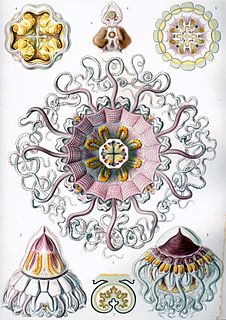
Periphyllidae is a family of jellyfish containing four genera and six species. The most well-known member of the family, Periphylla periphylla, is usually considered a deep-sea species, but it forms large blooms in surface waters of Norwegian fjords.
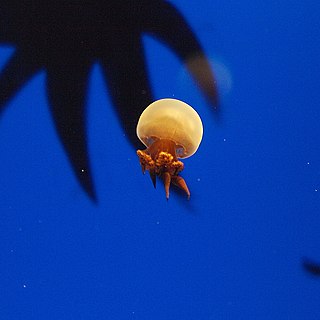
Rhopilema is a genus of jellyfish.

Chirodropidae is a family of venomous box jellyfish within the class Cubozoa. Like other members of the order Chirodropida, they have branched pedalia, in contrast to the unbranched pedalia of box jellyfish in the order Carybdeida. Each branch houses its own individual tentacle. Nematocyst composition and type can vary among individuals within this family based on body size and life stage. Like other box jellyfish, chirodropids can be found in coastal and shallow marine areas, but they have also been found to occur at benthic depths.

Atolla is a genus of crown jellyfish in the order Coronatae. The genus Atolla was originally proposed by Haeckel in 1880 and elevated to the monotypic family level, as Atollidae by Henry Bigelow in 1913. The six known species inhabit the mesopelagic zone. The medusae possess multiple lobes called lappets at the bell margin. Medusae also have eight tentacles, alternating with eight rhopalia, and twice as many lappets occur as tentacles.
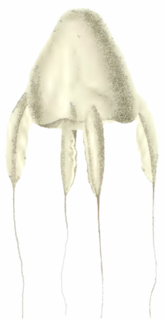
Alatinidae is a family of box jellyfish within class Cubozoa, containing the following genera and species:

Cyanea is a genus of jellyfish, primarily found in northern waters of the Atlantic and Pacific Oceans and southern Pacific waters of Australia and New Zealand, there are also several boreal, polar, tropical and sub-tropical species. Commonly found in and associated with rivers and fjords. The same genus name has been given to a genus of plants of the Hawaiian lobelioids, an example of a parahomonym.
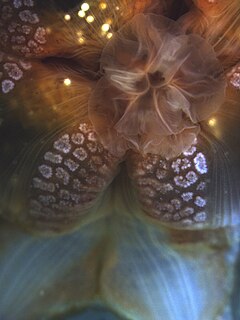
Lucernariidae is a family of stalked jellyfish containing two genera.

Tamoya is a genus of box jellyfish within the monotypic family Tamoyidae.
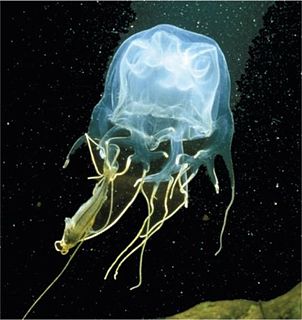
Chirodropus is a genus of box jellyfish in the family Chirodropidae.

Ulmaris is a genus of jellyfish in the family Ulmaridae.
Lychnorhiza is a genus of jellyfish in the family Lychnorhizidae.

Coronamedusae is a subclass of jellyfish in the class Scyphozoa. It is the sister taxon of Discomedusae and contains about 50 named species, all included in the order Coronatae. Jellyfish in this subclass are either small medusae living in shallow marine environments, or large medusae living in the deep sea.
Linantha is a genus of crown jellyfish in the family Linuchidae. It is a monotypic genus and the only species is Linantha lunulata which was first described by the German biologist Ernst Haeckel in 1880. It is found in the tropical eastern Pacific Ocean in the vicinity of the Galápagos Islands.

Thysanostomatidae is a family of true jellyfish from the Indo-Pacific. The first sighting of Thysanostoma loriferum in Hong Kong; extending its known range from the Philippines, the Malay Archipelago, and Hawaii; was from the Hong Kong Jellyfish Citizen Science project and sightings on iNaturalist.

Cassiopea ornata are one of many Cnidarian species called the upside-down jellyfish. This pelagic jellyfish primarily lives in tropical waters, off the coast of Australia in shallow lagoons and around mangrove trees. The name "upside-down jellyfish" comes from the fact that it appears to be upside-down in its natural state—resting on its bell. Its bell is a golden/brown color and the tentacles vary with different shades of yellow. While the sighting of this particular species is rare, it is usually mistaken for vegetation like the other species in genus Cassiopea.

Nausithoe is a genus of jellyfishes belonging to the family Nausithoidae.
Pseudorhiza haeckeli, or Haeckel's jelly, is a species of cnidarian of the family Lychnorhizidae. The species is a carnivore with a mild sting. It is native to temperate and sub-tropical Australian marine waters. It has been observed at depths of 1-30 metres, and is sometimes found cast on beaches. It was described by the naturalist Wilhelm Haacke in 1884, and named for his mentor Ernst Haeckel.